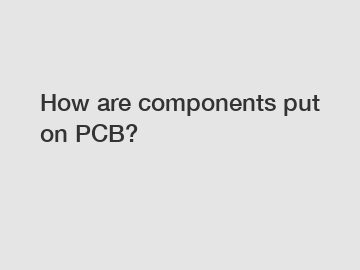How are components put on PCB?
How are components put on PCB?
Components are an essential part of any electronic circuit, and they are mounted on a Printed Circuit Board (PCB) using various techniques. The process of placing components on a PCB involves several steps and requires attention to detail. In this article, we will explore the process of how components are put on a PCB, discuss the significance of this process, and highlight its impact on overall circuit performance.
The process of placing components on a PCB begins with the design phase. Engineers carefully design the layout of the circuit, taking into consideration factors such as component type, size, and electrical requirements. Once the design is finalized, the next step is to prepare the PCB for component placement.

During the PCB assembly, the first step is to apply a solder paste onto the board. The solder paste is a sticky mixture of flux and tiny solder balls that helps in soldering the components to the board. After applying the solder paste, the next step is to carefully place the components on the board.
There are several methods for placing components on a PCB. The two most common techniques are manual placement and automated placement using pick-and-place machines. In the manual placement method, skilled technicians place the components on the solder paste using specialized tools. This method requires precision and is suitable for low-volume production.
On the other hand, automated placement involves the use of pick-and-place machines. These machines precisely pick the components from the feeders and place them on the board with high accuracy and speed. This method is ideal for high-volume production as it saves time and ensures consistency in component placement.
After the components are placed on the board, the next step is to solder them securely. The PCB is heated, either through a reflow oven or a wave soldering machine, to melt the solder paste and establish a strong electrical and mechanical connection between the components and the board. The excess solder is removed, and the board is inspected for any defects.
The placement of components on a PCB is a critical process as it determines the electrical performance, reliability, and overall functionality of the circuit. Proper component placement ensures that the circuit operates as intended and reduces the risk of failures or malfunctions.
In conclusion, the process of how components are put on a PCB involves careful planning, precise placement, and secure soldering. Whether done manually or with automated machines, this process plays a crucial role in achieving a functioning and reliable electronic circuit. By understanding and implementing the correct placement techniques, engineers can optimize circuit performance and ensure the stability and longevity of electronic devices.
If you want to learn more, please visit our website X Ray Counter Machine, X-Ray Counting Systems, High Speed Smt X-Ray Intelligent Counter Machine.


